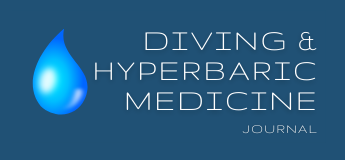Born in Tasmania in 1960, David started scuba diving in 1981. Since graduating in 1984, he has always been active in diving and hyperbaric medicine, spending many hours when an  intern as ‘nurse’ attendant in the old Royal Hobart Hospital (RHH) hyperbaric chamber, while his more senior colleagues supervised. He completed his DipDHM in 1987 and FACEM in Emergency Medicine in 1991. After time in Adelaide and Fremantle, he returned to Hobart, and in 1995 he was appointed Director of Emergency Medicine, and Chair of the Scientific Committee (ACEM), as well as working in hyperbaric medicine. In 1998, he became Medical Co-director of Diving and Hyperbaric Medicine at RHH, and the following year was appointed Clinical Associate Professor in Diving and Hyperbaric Medicine, Faculty of Health Sciences, UTas; all this and running a private emergency medicine facility! Whilst in Fremantle, he commenced research on expired carbon monoxide (CO) as a marker for CO poisoning, but because of his clinical commitments, this took many years to complete as a doctoral dissertation. David has been heavily involved in diving medicine in numerous roles including medical consultant to various professional diving industry organisations; an examiner in Diving and Hyperbaric Medicine, ANZCA; Chairperson of the ANZHMG; SPUMS Education Officer; SPUMS representative on the Australian Standards Committee on Occupational Diving, and in 2017 was re-elected SPUMS President for a second term. David now works full-time in Diving and Hyperbaric Medicine, and is heavily involved in the strategic development of Post-Graduate training in Hyperbaric Medicine. He also actively teaches at three of Australia’s courses in Diving and Hyperbaric Medicine, and has over 130 published scientific papers and abstracts. He has received national and international awards: The Derek Craig award (ADAS), Fellowship of Undersea and Hyperbaric Medicine (UHMS), and Excellence in Commercial Diving Award (UHMS). In 2014, he was invited to provide medical supervision of the Australian Antarctic Diving Program at Casey Base. His research interests include: Doppler analysis of decompression stress; Doppler validation of sub-2400 m ascent to altitude guidelines; hookah diving safety, inner ear barotrauma, HBOT for lower limb trauma, oxygen delivery systems, diving risk management and in-chamber monitoring equipment. He is married with two daughters (both with gills!), and pursues many hobbies; carpentry and joinery, swimming, scuba diving, boating and fishing, and underwater photography.
intern as ‘nurse’ attendant in the old Royal Hobart Hospital (RHH) hyperbaric chamber, while his more senior colleagues supervised. He completed his DipDHM in 1987 and FACEM in Emergency Medicine in 1991. After time in Adelaide and Fremantle, he returned to Hobart, and in 1995 he was appointed Director of Emergency Medicine, and Chair of the Scientific Committee (ACEM), as well as working in hyperbaric medicine. In 1998, he became Medical Co-director of Diving and Hyperbaric Medicine at RHH, and the following year was appointed Clinical Associate Professor in Diving and Hyperbaric Medicine, Faculty of Health Sciences, UTas; all this and running a private emergency medicine facility! Whilst in Fremantle, he commenced research on expired carbon monoxide (CO) as a marker for CO poisoning, but because of his clinical commitments, this took many years to complete as a doctoral dissertation. David has been heavily involved in diving medicine in numerous roles including medical consultant to various professional diving industry organisations; an examiner in Diving and Hyperbaric Medicine, ANZCA; Chairperson of the ANZHMG; SPUMS Education Officer; SPUMS representative on the Australian Standards Committee on Occupational Diving, and in 2017 was re-elected SPUMS President for a second term. David now works full-time in Diving and Hyperbaric Medicine, and is heavily involved in the strategic development of Post-Graduate training in Hyperbaric Medicine. He also actively teaches at three of Australia’s courses in Diving and Hyperbaric Medicine, and has over 130 published scientific papers and abstracts. He has received national and international awards: The Derek Craig award (ADAS), Fellowship of Undersea and Hyperbaric Medicine (UHMS), and Excellence in Commercial Diving Award (UHMS). In 2014, he was invited to provide medical supervision of the Australian Antarctic Diving Program at Casey Base. His research interests include: Doppler analysis of decompression stress; Doppler validation of sub-2400 m ascent to altitude guidelines; hookah diving safety, inner ear barotrauma, HBOT for lower limb trauma, oxygen delivery systems, diving risk management and in-chamber monitoring equipment. He is married with two daughters (both with gills!), and pursues many hobbies; carpentry and joinery, swimming, scuba diving, boating and fishing, and underwater photography.
(Photo taken during his Antarctic work with AAD.)
